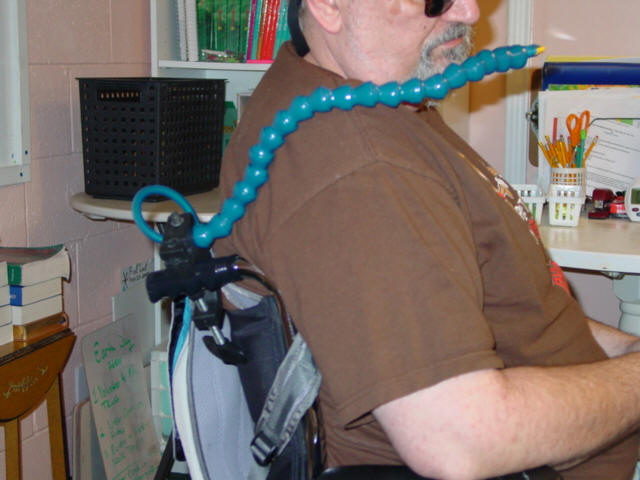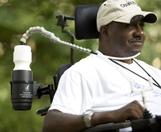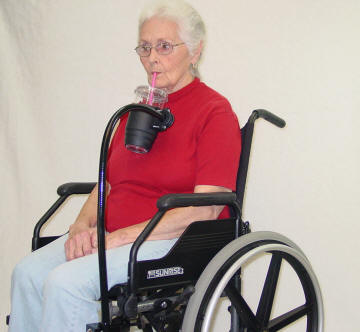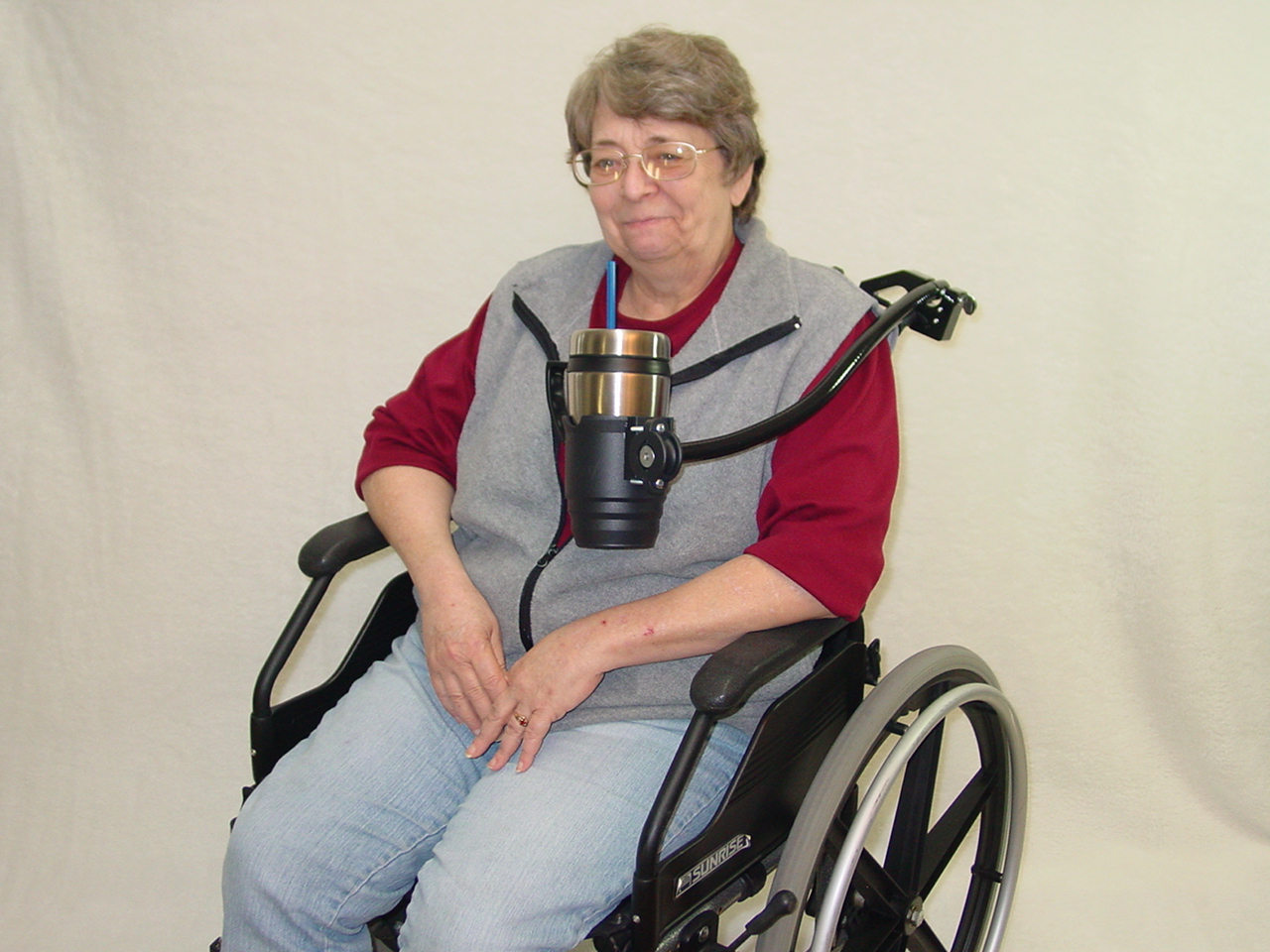Mealtime Partners, Inc.
Specializing in Assistive Dining and Drinking Equipment
September 2012 Independent Eating and Drinking Newsletter
 |
September Topics:
|
||
|
Mealtime Partners Home Page Send a Comment or Suggestion |
|||
| Subscribe to Newsletters |
Most people eat and drink without any problems. However, some individuals, who are born with disabilities, and to a lesser degree, those with acquired disabilities, may experience some level of eating difficulty from birth, or shortly thereafter. The troubles may have one or more causes including structural abnormalities, sensory and/or motor impairments, digestive problems that triggers reflux, that, in turn, causes pain and the development of resistance to eating. This article will discuss some common problems that make eating and drinking difficult for both the individual eating and their caregiver.
Inability or difficulty, latching onto a nipple (whether on a breast or a bottle), or lacking the ability to suck, and/or weak sucking. – An early problem seen in babies is difficulty with sucking which often leads to the infant having difficulty consuming enough food to sustain themselves. To be able to intake nutrition safely, it is necessary for all infants to develop the ability to suck, swallow, and breathe in a coordinated fashion. If a baby does not develop the ability to suck, food will need to be provided in an alternate way. The most common method is a tube that is threaded through the nose and esophagus, and into the stomach. This is called a nasogastric feeding tube or NG-tube. It is typically used as a short term solution to feeding problems. Should the problem persist, it is likely that a more permanent solution will be used. The gastric feeding tube, or G-tube, is a tube that is surgically inserted into the stomach and is used permanently, or over an extended time frame, to provide nutrition. Additionally, there is a jejunostomy feeding tube (J-tube) that is a tube that is surgically inserted through the abdomen and into the jejunum (the second part of the small intestine). A J-tube is used to avoid the risk of aspiration for those who have reflux problems and who aspirate when they receive food directly into their stomach.
Tonic bite reflex. – The definition of a tonic bite reflex is “reflexive, sustained jaw closure, accompanied by increased abnormal tone in the jaw muscles, in response to stimulation of the teeth or gums. It is difficult to release, and its force can damage the teeth or an object placed in the mouth." It is a swift, involuntary biting action that may be triggered by stimulation of the oral cavity. The bite can be difficult to release in some cases, such as when a spoon or tongue depressor is placed in a patient's mouth. A reflex is a movement that is triggered by the nervous system but does not require conscious thought. An example of a reflex that would be familiar to most people is when a doctor taps the knee with an instrument and the leg jerks upward. The movement of the leg is not triggered by conscious thought but by a reflex.
For those who have a tonic bite reflex, mealtimes can be extremely challenging. It can be caused by hypersensitivity of the mouth, the oral cavity, or surrounding area of the face. Additionally, seeing a spoonful of food approaching their mouth can trigger a tonic bite reflex for some people. This presents confusing messages to the person offering food. In some cases the early mouth closure can indicate that the person does not want more food, yet for someone with a tonic bite reflex that is triggered by the sight of food being offered, it might simply be an involuntary response when they really want another bite of food. The next situation is when the food is successfully delivered into the mouth. Once the jaw has clamped down on a spoon the jaw tension is sustained much longer than needed (or is normal), and the individual is unable to release their jaw even though they want to. Because the spoon is clamped in the person’s mouth and they are unable to let go of it, the feeding partner may attempt to remove it before the involuntary jaw closure is released. They may attempt this by either pulling it straight out of the mouth, or by wiggling it from side to side to get it out of the mouth and, in both cases, this may be painful or damage tissue in or around the mouth. The caregiver must learn to be patient with individuals with tonic bite reflex!
It is also very important that the person demonstrating a tonic bite reflex be seated and positioned with well supported feet and buttocks, their shoulders rounded forward, and their head tilted forward into a chin-tuck to reduce the reflexive response. In addition, for these individuals, it is extremely important that the environment is quiet and calm and does not over stimulate them.
Tongue thrust. –A tongue thrust is part of an infant’s normal eating pattern. They extend their tongue forward beyond the lower gums in their mouth and move it in a forward and backward movement that, when upward pressure is applied, draws milk into their mouth from a nipple. This is part of the motion of sucking. However, as the infant matures and reduces their consumption of milk in favor of solid and semi-solid foods, the tongue thrust is reduced and eventually stops. Typically by age 7 most children do not exhibit a tongue thrust. However, for infants with developmental delays, the tongue thrust may remain for an extended period or, in some cases, be permanent. A permanent tongue thrust causes problems with the teeth because it can push them out of alignment. It can also increase the incidence of drooling because the mouth remains open. During eating, a tongue thrust will work against the intake of food. Instead of being part of the process of bringing food into the mouth, the tongue extends during the intake of food, pushing the food out of the mouth.
Both a tonic bite reflex and a tongue thrust create difficulties with providing oral care. When addressing strategies for improving eating skills, oral hygiene should also be addressed as bad teeth simply worsen the oral motor problems that are being experienced.
The problems described above are just a few of the difficulties that contribute to eating being a struggle for some people. In all cases of eating difficulties, it is advisable to consult your pediatrician or physician and to work with a team of clinical experts who understand how to treat eating problems.
| Hands-Free Drinking
Systems |
|||
| Many people with
disabilities suffer from some level of dehydration almost
constantly. However, for most individuals,
dehydration is 100% preventable. Being able to drink at will
is important to overall health and is significant to
quality of life. If someone can drink using a straw, they can most likely use one of Mealtime Partners hands-free drinking systems. A hands-free drinking system can enable them to drink independently so that they can keep themselves properly hydrated, and will not have to continuously depend on someone else to provide every sip of liquid for them. Mealtime Partners, Inc. has several different types of hands-free drinking systems to choose from: the Hydration Backpack with Drinking Tube Positioning; the Drink Aide; and the Front Mounted Drinking System. They can all be easily attached to a wheelchair and can be positioned to meet the individual user’s need. The Drink Aide bottle holds 28 fluid ounces and is suitable for someone who has good suction and can pucker their lips. The 70 fluid ounce Hydration Backpack is well suited for providing enough water to last for long periods without requiring replenishing. The Front Mounted Drinking System can hold cups, cans and other disposable containers for drinking a variety of beverages using a disposable straw. Because it holds user-provided disposable components, it is the easiest to clean and to replenish. |
|||
  |
|||
| Hydration Backpack with Drinking Tube Positioning | The Drink Aide | ||
  The Front Mounted Drinking System |
|||
| To view all of the Mealtime Partners drinking products, click here. For additional guidance about how to select the appropriate drinking system for your specific needs, click here. | |||
The Importance of Seating and Positioning for Eating and Drinking
Over the past few years Mealtime Partners Newsletters have included several articles about the importance of correct seating and positioning for safe eating and drinking. There are several different issues that should be considered and this article will review some considerations that should be kept in mind when preparing a mealtime environment for someone who does not eat independently, or, who cannot take a drink without assistance.
The previous article in this Newsletter discusses eating difficulties. For people who experience these difficulties it is essential for them to be positioned appropriately at mealtimes for them to become proficient eaters. Inappropriate positioning can make eating more difficult and even dangerous, especially for those who have a tonic bite reflex or a tongue thrust. If providing food is difficult, there is a high likelihood that the individual will eat less because of the complexities associated with their meals; they are then much more likely to be under nourished, which leads to many other health issues.
Eating – For individuals who cannot feed themselves, it is important that they be seated in a stable position that puts their head in a position that enables them to open and close their mouth with ease, chew freely, and swallow without difficulty or triggering a gag reflex. The essential things to remember are that the feet, thighs and buttocks need to all bear weight throughout the meal. Once they are weight bearing the positioning of the trunk and arms should be considered. The trunk should be stabilized over the buttocks and, if necessary, should be provided additional lateral support to maintain a stable, upright position for the entire meal. The arms should be resting either on arm supports (for a power wheelchair user) or on a laptray or other surface for those who sit in a manual wheelchair, adapted chair, or regular chair. If the forearms are supported appropriately, the shoulders will “role” forward and down slightly which will promote a suitable head position for eating. It is important that the trunk does not bend forward but rather is maintained in an aligned position where the buttocks provides the foundation for the hips and, in turn, the rib cage. This allows the transport of food from the mouth to the stomach to be executed as efficiently as possible. If the individual slumps, the rib cage will sit on the stomach and make the food transport process more difficult. If the person is tilted backward, gravity pulls the head up and the swallowing process has a higher risk of causing choking. Therefore, the correct position is important and all of the subtleties associated with achieving the best positioning for each person should be identified and used at every meal.
Drinking - Good hydration is an essential part of maintaining a healthy body and general feeling of well-being. It is especially important to address the issue of providing enough fluids for those who are dependent upon another person for providing of all of their liquids. Because they are unable to take a drink when their body feels the need for liquid, they tend to drink less than they would if they could take a drink whenever they wanted. When being provided a drink by someone else, it is common for the person drinking to intake a very large volume if liquid in big gulps when they are presented with the opportunity for a drink. This puts the person drinking at a greater risk of choking because when you take repeated big swallows of liquid, with every swallow that is hurriedly taken the risk of choking increases (refer to the July 2010 Newsletter article: Piecemeal Deglutination for more information about this risk).
Therefore, the desirable drinking environment is one in which an individual can take sips of liquid whenever they want. Sip after sip of liquid throughout the day is far safer than hurried, big gulps of liquid once in a while throughout the day.
When someone who cannot drink independently and must always be provided a drink by another person, the method of providing a drink is important for their safety and good hydration. Those who must be given a drink typically are unable to suck through a straw and must have liquid tipped from a cup into their mouth. For those with a bite reflex it is likely that they will bite down before the cup is placed on their lip. It may take several attempts on the part of the caregiver before the edge of the cup is in the mouth and liquid is delivered into the mouth. For people who manifest this difficulty, a bottle with a spout is sometimes used. Many of the commercially available water bottles come with a spout and so do most sports bottles. The caregiver should keep in mind that when drinking from a spout bottle it is easy to tilt the head backwards, which exposes the person to the risk of choking. Regardless of how the liquid is delivered to the mouth (bottle or cup), the position of the individual is significant. Many people are placed in a slight recline position to receive fluids because a recline lessens the amount of liquid that falls out of their mouth. Reclining may make it easier for the caregiver to get liquid into the person’s mouth but it also increases the risk of liquid running to the back of their throat and causing them to choke. If a reclined position is used, it should be slight and the head should be tilted forward to produce a chin tuck. In this way the caregiver can provide liquid and have most of it stay in the person’s mouth; the person can then swallow safely after receiving the liquid.
For those who are able to drink through a straw or drinking tube, one of the hands free drinking systems from Mealtime Partners may help them drink independently.
More detailed information about seating and positioning for eating and drinking can be found in several of the earlier Mealtime Partners Newsletters as follows: the June 2009 Newsletter topic: Promoting a Chin Tuck for Safer Eating; the July 2009 Newsletter topic: Positioning for Eating; and the August 2010 Newsletter topic: How We Eat.
Additional information about safe drinking can be found in the following Newsletter topics: November 2009 - The Importance of Hydration; & Independent Drinking; and January 2011 - The High Cost of Dehydration.
|
Did You Know? Did you know that rare earth
magnets that are used in desk top toys are a serious risk
for children? They are balls about the size of BBs that,
when used as they are designed, stick together in various
shapes. They are marketed for adults and are clearly marked
that they are not suitable for children. However, children
find the little balls interesting and sometimes put them in
their mouths. One child thought that the balls were the same
thing as the decorations on the top of cakes. If more than
one of these magnets is swallowed they can cause extreme
problems, unlike other non-magnetic items that might be
swallowed, such as pennies that will pass straight through
the child. Once inside the child, these magnets are strong
enough to attach to one another through layers of skin. This
can cause an obstruction of the intestines because the
magnets can cause a fold in the intestinal tissue. They can
also perforate the tissue. There have been an estimated 1,700 cases of rare earth magnets being swallowed where the child required emergency room care. The Consumer Product Safety Commission has asked the manufactures to remove these products from the market, and all but one company has complied. Regardless, adults should be aware that these products are dangerous for children. |
Mealtime Partners Website Navigation:
Home | Dining | Drinking | Videos | All Products | Warranty | Ordering | Calendar | FAQ | Newsletters | Contact
Please send comments and suggestions to newsletters@mealtimepartners.com
Copyright © Mealtime Partners, Inc. 2012
All rights reserved.